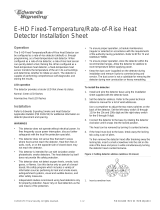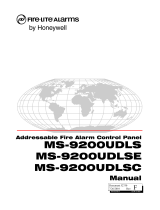Page is loading ...

© 2013 UTC Fire & Security. All rights reserved. 1 / 2 P/N 3101194 • REV 02 • REB 28JAN13
E-IDCWS Analog Dual Input Waterflow/
Supervisory Module Installation Sheet
Operation
The module is an analog addressable device used to connect
normally open waterflow alarm and supervisory initiating
device circuits (IDCs) to a control panel. This module is
designed for Class B circuit operation.
The device address is set using the two rotary switches located
on the front of the module. Two consecutive device addresses
are required. The second device address is automatically
assigned one number higher that the value set on the rotary
switches.
The module can operate in the following modes:
Table 1: Module operation
Operation
Device type description
Waterflow
Alarm latching delayed: Configures the module for use
with only nonretarded waterflow alarm switches. When
the NO input contact of an initiating device is closed, an
alarm is sent to the control panel, which after a 16
second time delay, generates an alarm signal.
Supervisory
Supervisory active nonlatching US marketplace
Supervisory active latching Canadian marketplace
Nonlatching: Configures the module for normally open
dry contact initiating devices. When the NO input
contact of an initiating device is closed, a supervisory
signal is sent to the control panel and the supervisory
condition is not latched at the module.
Latching: Configures the module for normally open dry
contact initiating devices. When the NO input contact of
an initiating device is closed, a supervisory signal is
sent to the control panel and the supervisory condition
is not latched at the module.
LED operation
The module provides a bicolor LED that shows its status.
Normal: Green LED flashes
Alarm/active: Red LED flashes
Installation
WARNINGS
• This module will not operate without electrical power. As
fires frequently cause power interruption, you should
discuss further safeguards with your local fire protection
specialist.
• This module does not support conventional smoke
detectors.
Note: The module is shipped from the factory as an assembled
unit; it contains no user-serviceable parts and should not be
disassembled.
To install the module:
1. Verify that all field wiring is free of opens, shorts, and
ground faults.
2. Make all wiring connections as shown in “Wiring.”
3. Set the module address as follows:
Use a screwdriver to adjust the two rotary switches on the
front of the module. Set the TENS rotary switch (0 through
12) for the 10s and 100s digit and the ONES rotary switch
for the 0 through 9 digit. For example: device address 21,
set TENS rotary switch to 2 and set the ONES rotary
switch to 1.
Refer to “Specifications” for available address numbers.
4 Mount the module on the electrical box using screws
provided with the electrical box.
5. Mount the wall plate on the module using #4-24 x 1/2 in.
(13 mm) self-tapping screws.
Figure 1: Module address
Insert
screwdriver
here

2 / 2 P/N 3101194 • REV 02 • REB 28JAN13
Figure 2: Module installation
Screw
4-24
screws
Module
Wall plate
Compatible
electrical box
Wiring
Wire in accordance with NFPA 72 and CAN/ULC-S524. Be
sure to observe the polarity of the wires as shown in the
diagram.
Specifications
Communication line voltage
Maximum 20.6 V peak-to-peak
Current
Standby
Activated
550 μA
725μA
Ground fault impedance
10 kΩ
Operating environment
Temperature
Humidity
32 to 120° F (0 to 49° C)
0 to 93% RH
Stor
age temperature range –4 to 140° F (–20 to 60° C)
Compatible electrical boxes
North American 4 inch square x
2-1/2 in. (64 mm) deep 2 gang box
Standard 4 in. square box 1-1/2 in.
(38 mm) deep
Wire size
12, 14, 16, or 18 AWG wire (2.5, 1.5,
1.0, or 0.75 mm
2
) (Sizes 16 and 18
AWG are preferred)
Device address
01 to 63 (64 point control panel)
01 to 126 (127 point control panel)
Initiating device circuit (IDC)
EOL resistor value
Max. circuit resistance
Max. circuit capacitance
47 kΩ, (P/N: EOL-47)
50 Ω (25 Ω per wire)
0.1 μF
Figure 3: Module wiring
Typical NO
Waterflow Switch
47
EOLR
kΩ
47
EOLR
kΩ
SUP.
Style B (Class B)
[1] [2] [4]
W/FLOW
Typical NO
Supervisory/
Tamper Switch
[3]
TB2 TB1
(+)
(+)
SLC
(+)
( )
( )
( )
From
previous
device
To next
device
SLC out (+)
SLC out
SLC in
SLC in (+)
( )
( )
[1] Maximum 25 Ω resistance per wire
[2] Maximum 12 AWG (2.5 mm
2
) wire; minimum 18 AWG (0.75 mm
2
) wire
[3] Refer to the control panel technical reference manual for wiring specifications
[4] Maximum 10 VDC at 350 μA
5. All wiring is power-limited and supervised
6. This module will not support two-wire smoke detectors
/





